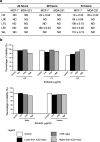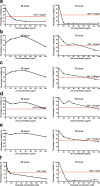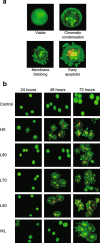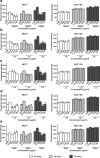The cytotoxic effect and glucose uptake modulation of Baeckea frutescens on breast cancer cells
- PMID: 31426778
- PMCID: PMC6700976
- DOI: 10.1186/s12906-019-2628-z
The cytotoxic effect and glucose uptake modulation of Baeckea frutescens on breast cancer cells
Abstract
Background: Baeckea frutescens (B. frutescens) of the family Myrtaceae is a plant that has been used in traditional medicine. It is known to have antibacterial, antipyretic and cytoprotective properties. The objective of this study is to explore the mechanism of B. frutescens leaves extracts in eliminating breast cancer cells.
Method: B. frutescens leaves extracts were prepared using Soxhlet apparatus with solvents of different polarity. The selective cytotoxicity of these extracts at various concentrations (20 to 160 μg/ml) were tested using cell viability assay after 24, 48 and 72 h of treatment. The IC50 value in human breast cancer (MCF-7 and MDA-MB-231) and mammary breast (MCF10A) cell lines were determined. Apoptotic study using AO/PI double staining was performed using fluorescent microscope. The glucose uptake was measured using 2-NBDG, a fluorescent glucose analogue. The phytochemical screening was performed for alkaloids, flavonoids, tannins, triterpenoids, and phenols.
Results: B. frutescens leaves extracts showed IC50 value ranging from 10 -127μg/ml in MCF-7 cells after 72 h of treatment. Hexane extract had the lowest IC50 value (10μg/ml), indicating its potent selective cytotoxic activity. Morphology of MCF-7 cells after treatment with B. frutescens extracts exhibited evidence of apoptosis that included membrane blebbing and chromatin condensation. In the glucose uptake assay, B. frutescens extracts suppressed glucose uptake in cancer cells as early as 24 h upon treatment. The inhibition was significantly lower compared to the positive control WZB117 at their respective IC50 value after 72 h incubation. It was also shown that the glucose inhibition is selective towards cancer cells compared to normal cells. The phytochemical analysis of the extract using hexane as the solvent in particular gave similar quantities of tannin, triterpenoids, flavonoid and phenols. Presumably, these metabolites have a synergistic effect in the in vitro testing, producing the potent IC50 value and subsequently cell death.
Conclusion: This study reports the potent selective cytotoxic effect of B. frutescens leaves hexane extract against MCF-7 cancer cells. B. frutescens extracts selectively suppressed cancer cells glucose uptake and subsequently induced cancer cell death. These findings suggest a new role of B. frutescens in cancer cell metabolism.
Keywords: Apoptosis; Baeckea frutescens; Breast cancer; Glucose uptake; Oxidative phosphorylation.
Conflict of interest statement
The authors declare that they have no competing interests.
Figures




Similar articles
-
The cytotoxic effect of Baeckea frustescens extracts in eliminating hypoxic breast cancer cells.BMC Complement Med Ther. 2021 Oct 1;21(1):245. doi: 10.1186/s12906-021-03417-9. BMC Complement Med Ther. 2021. PMID: 34598696 Free PMC article.
-
The Cytotoxic Properties of Baeckea frutescens Branches Extracts in Eliminating Breast Cancer Cells.Evid Based Complement Alternat Med. 2019 Apr 23;2019:9607590. doi: 10.1155/2019/9607590. eCollection 2019. Evid Based Complement Alternat Med. 2019. PMID: 31178918 Free PMC article.
-
Evaluation of selected biological capacities of Baeckea frutescens.BMC Complement Altern Med. 2015 Jun 17;15:186. doi: 10.1186/s12906-015-0712-6. BMC Complement Altern Med. 2015. PMID: 26081250 Free PMC article.
-
In Vitro Cytotoxic Activity of African Plants: A Review.Molecules. 2022 Aug 5;27(15):4989. doi: 10.3390/molecules27154989. Molecules. 2022. PMID: 35956938 Free PMC article. Review.
-
Nanoencapsulation of extracts and isolated compounds of plant origin and their cytotoxic effects on breast and cervical cancer treatments: Advantages and new challenges.Toxicon. 2024 Jun;244:107753. doi: 10.1016/j.toxicon.2024.107753. Epub 2024 May 11. Toxicon. 2024. PMID: 38740098 Review.
Cited by
-
The cytotoxic effect of Baeckea frustescens extracts in eliminating hypoxic breast cancer cells.BMC Complement Med Ther. 2021 Oct 1;21(1):245. doi: 10.1186/s12906-021-03417-9. BMC Complement Med Ther. 2021. PMID: 34598696 Free PMC article.
-
Chemical Composition of a Supercritical Fluid (Sfe-CO2) Extract from Baeckea frutescens L. Leaves and Its Bioactivity Against Two Pathogenic Fungi Isolated from the Tea Plant (Camellia sinensis (L.) O. Kuntze).Plants (Basel). 2020 Aug 29;9(9):1119. doi: 10.3390/plants9091119. Plants (Basel). 2020. PMID: 32872535 Free PMC article.
-
Honokiol inhibits the growth of hormone-resistant breast cancer cells: its promising effect in combination with metformin.Res Pharm Sci. 2023 Aug 20;18(5):580-591. doi: 10.4103/1735-5362.383712. eCollection 2023 Sep-Oct. Res Pharm Sci. 2023. PMID: 37842518 Free PMC article.
-
Mushroom-Derived Compounds as Metabolic Modulators in Cancer.Molecules. 2023 Feb 2;28(3):1441. doi: 10.3390/molecules28031441. Molecules. 2023. PMID: 36771106 Free PMC article. Review.
-
Tri-chalcone suppressed breast cancer cell proliferation and induced apoptosis through intrinsic and extrinsic pathways.Naunyn Schmiedebergs Arch Pharmacol. 2024 Nov;397(11):8993-9006. doi: 10.1007/s00210-024-03220-6. Epub 2024 Jun 14. Naunyn Schmiedebergs Arch Pharmacol. 2024. PMID: 38874806
References
-
- Bean AR. A revision of Baeckea (Myrtaceae) in eastern Australia, Malesia and south-East Asia. Telopea. 1997;7:245–268. doi: 10.7751/telopea19971018. - DOI
MeSH terms
Substances
LinkOut - more resources
Full Text Sources
Medical
Research Materials
Miscellaneous

